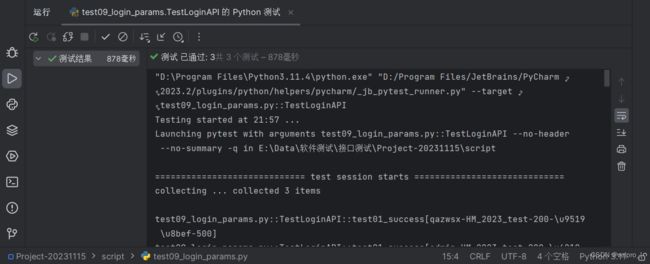单接口测试及数据驱动
以登录为例:
登录接口封装:
# 接口对象层:接口对象的封装调用
# 接口信息
# 验证码:http://kdtx-test.itheima.net/api/captchaImage
# 方法:get
# 登录: http://kdtx-test.itheima.net/api/login
# 方法:Post
# 请求数据:
# 请求头: Content-Type: application/json
# 请求体:("username":"admin","password":"HM_2023_test","code":"2","uuid":"验证码接口返回数据")
# 接口封装时,重点是依据接口文档封装接口信息,需要使用的测试数据是从测试用例传递的、接口方法被调用时需要返回对应的响应结果
# 导包
import requests
# 创建接口类
class LoginAPI:
# 初始化
def __init__(self):
# 指定url信息
self.url_verify = "http://kdtx-test.itheima.net/api/captchaImage"
self.url_login = "http://kdtx-test.itheima.net/api/login"
# 验证码
def get_verify_code(self):
return requests.get(url=self.url_verify)
# 登录
def login(self, test_data):
return requests.post(url=self.url_login, json=test_data)
测试脚本:
# 导包
from api.login import LoginAPI
# 创建测试类
class TestLoginAPI:
# 初始化
uuid = None
# 前置处理 setup()函数主要是进行测试前的初始化工作,比如:在接口测试前面做一些前置的参数赋值,数据库操作等等。
def setup(self):
# 实例化接口类
self.login_api = LoginAPI()
# 获取验证码
response = self.login_api.get_verify_code()
print(response.json())
# 提取验证码接口返回的uuid参数值
TestLoginAPI.uuid = response.json().get("uuid")
print(TestLoginAPI)
# 后置处理 teardown()函数是测试后的清除工作,比如:参数还原或销毁,数据库的还原恢复等
def teardown(self):
pass
# 登陆成功
def test01_success(self):
login_data={
"username": "admin",
"password": "HM_2023_test",
"code": "2",
"uuid": TestLoginAPI.uuid
}
response = self.login_api.login(test_data=login_data)
# 断言响应状态码为200
assert 200 == response.status_code
# 断言响应数据中包含“成功”
assert '成功' in response.text
# 断言响应json数据中的code值
assert 200 == response.json().get("code")
# 登陆失败(用户名为空)
def test02_without_uername(self):
login_data = {
"username": "",
"password": "HM_2023_test",
"code": "2",
"uuid": TestLoginAPI.uuid
}
response = self.login_api.login(test_data=login_data)
# 断言响应状态码为200
assert 200 == response.status_code # 相等断言
# 断言响应数据中包含“错误”
assert '错误' in response.text # 包含断言
# 断言响应json数据中的code值
assert 500 == response.json().get("code")
# 登陆失败(未注册用户)
def test03_username_no_exist(self):
login_data = {
"username": "qazwsx",
"password": "HM_2023_test",
"code": "2",
"uuid": TestLoginAPI.uuid
}
response = self.login_api.login(test_data=login_data)
# 断言响应状态码为200
assert 200 == response.status_code
# 断言响应数据中包含“错误”
assert '错误' in response.text
# 断言响应json数据中的code值
assert 500 == response.json().get("code")
当测试用例过多或需要修改测试数据时,此方法可维护性就比较差,那么就需要使用数据驱动
数据驱动 : 以测试数据驱动脚本执行,维护焦点从脚本转向测试数据的一种自动化
测试设计模式。实现测试数据与测试代码分开管理。
需要引入pytest:import pytest
数据驱动代码:
# 导包
from api.login import LoginAPI
import pytest
import json
# 测试数据 --------- 需要放在json文件中
# test_data = {
# ("admin", "HM_2023_test", 200, "成功", 200),
# ("", "HM_2023_test", 200, "错误", 500),
# ("qazwsx", "HM_2023_test", 200, "错误", 500)
# }
# 读取json数据文件
def build_data(json_file):
# 定义空列表
test_data = []
# 打开json文件
with open(json_file, "r", encoding="UTF-8") as f:
# 加载json文件数据
json_data = json.load(f)
# 循环遍历测试数据
for case_data in json_data:
# 转换数据格式[{},{}] ==> [(),()]
username = case_data.get("username")
password = case_data.get("password")
status = case_data.get("status")
message = case_data.get("message")
code = case_data.get("code")
test_data.append((username, password, status, message, code))
# 返回处理后的测试数据
return test_data
# 创建测试类
class TestLoginAPI:
# 初始化
uuid = None
# 前置处理 setup()函数主要是进行测试前的初始化工作,比如:在接口测试前面做一些前置的参数赋值,数据库操作等等。
def setup(self):
# 实例化接口类
self.login_api = LoginAPI()
# 获取验证码
response = self.login_api.get_verify_code()
print(response.json())
# 提取验证码接口返回的uuid参数值
TestLoginAPI.uuid = response.json().get("uuid")
print(TestLoginAPI)
# 后置处理 teardown()函数是测试后的清除工作,比如:参数还原或销毁,数据库的还原恢复等
def teardown(self):
pass
# 登陆成功
# @pytest.mark.parametrize("username,password,status,message,code", test_data)
@pytest.mark.parametrize("username,password,status,message,code", build_data(json_file="../data/login.json"))
def test01_success(self, username, password, status, message, code):
login_data = {
"username": username,
"password": password,
"code": "2",
"uuid": TestLoginAPI.uuid
}
response = self.login_api.login(test_data=login_data)
# 断言响应状态码为200
assert status == response.status_code
# 断言响应数据中包含“成功”
assert message in response.text
# 断言响应json数据中的code值
assert code == response.json().get("code")
json文件:
[
{
"username": "admin",
"password": "HM_2023_test",
"status": 200,
"message": "成功",
"code": 200
},
{
"username": "",
"password": "HM_2023_test",
"status": 200,
"message": "错误",
"code": 500
},
{
"username": "qazwsx",
"password": "HM_2023_test",
"status": 200,
"message": "错误",
"code": 500
}
]
断言正确结果:
有参数时:
接口封装:
# 课程模块接口封装:核心在于依据接口文档实现接口信息封装、重点关注接口如何被调用
# URL:http://kdtx-test.itheima.net/api/clues/course
# 方法:Post
# 请求数据:
# 请求头:{"Content-Type":"application/json","Authorization":"xxx"}
# 请求体:{"name": "测试开发提升课01","subject": "6","price": 899,"applicablePerson": "2","info": "测试开发提升课01"}
# 导包
import requests
# 创建接口类
class CourseAPI:
# 初始化
def __init__(self):
self.url_add_course = "http://kdtx-test.itheima.net/api/clues/course"
# 参数在后面拼接
self.url_select_course="http://kdtx-test.itheima.net/api/clues/course/list"
# 课程添加
def add_course(self, test_data, token):
return requests.post(url=self.url_add_course, json=test_data, headers={"Authorization": token})
# 查询课程列表
def select_course(self,test_data,token):
return requests.get(url=self.url_select_course + f"/{test_data}",headers={"Authorization": token})脚本:
# 导包
from api.course import CourseAPI
from api.login import LoginAPI
# 创建测试类
class TestAddCourse:
# 初始化
TOKEN = None
# 前置处理
def setup(self):
# 初始化接口类
self.login_api = LoginAPI()
self.course_api = CourseAPI()
# 登录成功
# 获取验证码
res_v = self.login_api.get_verify_code()
# 登录
login_data = {
"username": "admin",
"password": "HM_2023_test",
"code": "2",
"uuid": res_v.json().get("uuid")
}
res_l = self.login_api.login(test_data=login_data)
TestAddCourse.TOKEN = res_l.json().get("token")
print(TestAddCourse.TOKEN)
# 查询存在的课程 --------- 参数拼接
def test01_select_success(self):
response = self.course_api.select_course(test_data="?name=测试开发提升课01", token=TestAddCourse.TOKEN)
# print(response.json())
# 断言
assert 200 == response.status_code # 响应状态码
assert "成功" in response.text # msg指定文字
assert 200 == response.json().get("code") # json返回数据中的code值
# 查询失败(用户未登录) --------- 参数拼接
def test02_selectt_fail(self):
response = self.course_api.select_course(test_data="?subject=6", token="xxx")
# print(response.json())
# 断言
assert 200 == response.status_code # 响应状态码
assert "失败" in response.text # msg指定文字
assert 401 == response.json().get("code") # json返回数据中的code值



